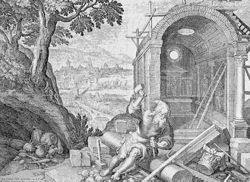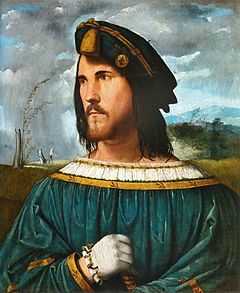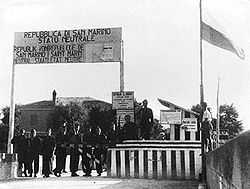History of San Marino
The history of San Marino is typical for the Italian Peninsula, and yet helps explain its unusual characteristics as the sole remaining Italian microstate.
San Marino is the only surviving Italian microstate. Like Andorra, Liechtenstein and Monaco, it appears an anachronism, a reminder of the times when Europe — particularly Germany, Italy and the Pyrenees — was made up of tiny political units, sometimes extending no further than a cannon could fire from a city’s walls. Along with Vatican City and Lesotho it is one of the three states surrounded by a single other country. San Marino asserts its independence and various treaties of friendship have been signed with Italy since the latter’s unification.
Origins

San Marino, the world's fifth-smallest state, claims to be the world's oldest surviving republic. According to tradition, San Marino was founded in 301 AD[1] when a Christian stonemason named Marinus the Dalmatian, later venerated as Saint Marinus, emigrated in 297 AD from the Dalmatian island of Rab, then a Roman colony, when the emperor Diocletian issued a decree calling for the reconstruction of the city walls of Rimini which had been destroyed by Liburnian pirates.[1] Finding persecution of his Christian beliefs, Marinus hid on the peak of Mount Titano (the highest of San Marino's seven hills) and founded a small community following Christian beliefs. The owner of the land, Felicissima, a sympathetic lady of Rimini, bequeathed it to the small Christian community of mountain dwellers, recommending to them to remain always united.
It is certain that the region has been inhabited since prehistoric times, although evidence of the existence of a community on Mount Titano dates back only to the Middle Ages. That evidence comes from a monk named Eugippio, who reports in several documents going back to 511 that another monk lived here. In memory of the stonecutter, the land was renamed "Land of San Marino", and was finally changed to its present-day name, "Republic of San Marino".
Later papers from the 9th century report a well organized, open and proud community: the writings report that the bishop ruled this territory.
In the Lombard age, San Marino was a fief of the dukes of Spoleto, but the free comune dates to the tenth century.
The original government structure was composed of a self-governed assembly known as the Arengo, which consisted of the heads of each family (as in the original Roman Senate, the Patres). In 1243, the positions of Captains Regent (Capitani Reggenti) were established to be the joint heads of state. The state's earliest statutes date back to 1263. The Holy See confirmed the independence of San Marino in 1631.
During the feudal era

In quick succession, the lords of Montefeltro, the Malatesta of Rimini, and the lords of Urbino attempted to conquer the little town, but without success. The land area of San Marino consisted only of Mount Titano until 1463, at which time the republic entered into an alliance against Sigismondo Pandolfo Malatesta, duke of Rimini, who was later defeated. As a result, Pope Pius II gave San Marino some castles and the towns of Fiorentino, Montegiardino and Serravalle. Later that year, the town of Faetano joined the republic on its own accord. Since then, the size of San Marino has remained unchanged.
As the political scientist Jorri Duursma notes, "San Marino does not have an official Constitution as such. The first legal documents which mentioned San Marino's institutional organs were the Statutes of 1600." Popular misunderstanding sometimes credit the country with a "written constitution" dating from 1600.[2][3][4]
San Marino faced many potential threats. Thus a treaty of protection was signed in 1602 with Pope Clement VIII, which came into force in 1631.
San Marino has been occupied by foreign militaries three times in its history, each for only a short period of time. Two of these periods were in the feudal era. In 1503, Cesare Borgia occupied the republic until his death several months later. On October 17, 1739, Cardinal Giulio Alberoni, legate (papal governor) of Ravenna who in 1739, aiding certain rebels, possibly contrary to the orders of Pope Clement XII, used military force to occupy the country, imposed a new constitution, and endeavored to force the Sanmarinesi to submit to the government of the Papal States. However, civil disobedience was used to protest this, and clandestine notes sent to the Pope to obtain justice were answered by papal recognition of San Marino's rights, which restored them to independence.
Napoleonic Wars
When French emperor Napoleon I completed his conquest of Northern Italy and began to push his armies towards the edges of the northern territories of the Papal State, San Marino found itself forced to choose between maintaining the alliance with the Papal State or creating a new one with France. An alliance could have meant the loss of its liberty so a prudent course of action was taken: not to take sides until it became inevitable.
San Marino finally had to make a choice on February 5, 1797, when, with the arrival of a letter from General Louis Alexandre Berthier addressed to the Regents, it was required to arrest and consign the Bishop of Rimini, Monsignor Vincenzo Ferretti, accused of instigating crimes against the French, who fled with all his possessions to San Marino. A refusal would have resulted in the immediate intervention of French troops.
The Government of San Marino replied that it would do everything possible to fulfill the request, even though, in reality, the bishop was able to flee across the border.
A solution was found by one of the Regents, Antonio Onofri, who managed to gain the respect and friendship of Napoleon. Thanks to his intervention, Napoleon, with a letter delivered to Gasparre Monge, scientist and commissary of the French Government for Science and Art, promised to guarantee and protect the independence of the Republic offering to extend its territory according to its needs. The offer was declined by San Marino, in fear of future vindications on the territories annexed, which would threaten San Marino's independence.
Napoleon issued orders that exempted San Marino's citizens from any type of taxation and gave them 1,000 quintals (over 2,200 lb or 1,000 kg) of wheat and four cannons, which, for reasons unknown, never arrived.[5]
The state was recognized by Napoleon by the Treaty of Tolentino, in 1797 and by the Congress of Vienna in 1815. In 1825 and 1853, new attempts to submit it to the Papal States failed; and its wish to be left out of Giuseppe Garibaldi's Italian unification in the mid-nineteenth century was granted, since it had offered a safe refuge to numerous supporters of unification in earlier years.
19th century
In the spring of 1861, shortly before the beginning of the American Civil War, the government of San Marino wrote a letter (in "perfect Italian on one side, and imperfect but clear English on the other"[6]) to United States President Abraham Lincoln, proposing an "alliance" between the two democratic nations and offering the President honorary San Marino citizenship. Lincoln accepted the offer, writing (with his Secretary of State, William H. Seward) in reply that San Marino proved that "government founded on republican principles is capable of being so administered as to be secure and enduring."[7]
Presaging a theme he would bring to the fore, using similar language, in his Gettysburg Address in 1863, Lincoln wrote: “You have kindly adverted to the trial through which this Republic is now passing. It is one of deep import. It involves the question whether a Representative republic, extended and aggrandized so much as to be safe against foreign enemies can save itself from the dangers of domestic faction. I have faith in a good result...."[6]
After the unification of the Kingdom of Italy a treaty in 1862 confirmed San Marino's independence. It was revised in 1872.
Towards the end of the 19th century, San Marino experienced economic depression: a large increase in the birth rate coupled with a widening of the gap between agricultural and industrial development led people to seek their fortunes in more industrialised countries.
The Sanmarinese first sought seasonal employment in Tuscany, Rome, Genoa and Trieste, but in the latter half of the century whole families were uprooted, with the first permanent migrations to the Americas (United States, Argentina and Uruguay) and to Greece, Germany and Austria.
This phenomenon lasted up to the 1870s, with a pause during the First World War and an increase during the Fascist period in Italy. Even today there are still large concentrations of San Marino citizens residing in foreign countries, above all, in the United States, in France and in Argentina. There are more than 15,000 San Marino citizens spread throughout the world.[1]
An important turning-point in the political and social life of the country took place on March 25, 1906, when the Arengo met; out of 1,054 heads of family, 805 were present.
Each head of family received a ballot which contained two questions: the first asking if the Government of San Marino should be headed by a Principal and Sovereign Council, and the second, if the number of members of the Council should be proportionate between the city population and the rural population. This was the first move towards a referendum and true democracy in San Marino. In the past, similar attempts were made by people such as Pietro Franciosi, but without results. In the same year a second referendum took place on May 5 dealing with the first electoral laws and on June 10 the first political elections in San Marino's history resulted in an overwhelming victory of the exponents of democracy.[1]
World War I
While Italy declared war on Austria–Hungary on 23 May 1915, San Marino remained neutral. Italy, suspecting that San Marino could harbour Austrian spies who could be given access to its new radiotelegraph station, tried to forcefully establish a detachment of Carabinieri on its territory and then suspended any telephone connections with the Republic when it did not comply.
Two groups of 10 volunteers each did join Italian forces in the fighting on the Italian front, the first as combatants and the second as a medical corps operating a Red Cross field hospital. It was the presence of this hospital that later caused Austrian authorities to suspend diplomatic relations with San Marino.[8]
Although propaganda articles appeared in the New York Times as early as 4 June 1915 claiming that San Marino declared war on Austria–Hungary,[9] the republic never entered the war.[1]
Inter-war Period
San Marino in the 1920s, still a largely agrarian society, experienced political turmoil influenced by the events in Fascist Italy, culminating in June 1921 in the murder in Serravalle of Italian doctor and Fascist sympathiser Carlo Bosi by local leftists, which led to condemnation by the surrounding Italian population and threats of retaliation by Italian squadristi. The government decided to ask Italy for help in the form of a detachment of 30 Carabinieri. As in Italy, Fascism eventually took over government of the Republic, the Sammarinese Fascist Party causing the Socialist newspaper Nuovo Titano to cease publication.
The 1930s was an era of public works and reinvention of the Republic's economy, with the construction of the San Marino-Rimini railway that connected it to the Italian railway network and modernization of the country's infrastructures that paved the way to its present status as a major tourist destination.[10]
World War II


San Marino was mostly uninvolved in the Second World War. In September 1940, press reports claimed that it had to have declared war on Britain in support of Italy;[11] however, this was later denied by the Sanmarinese government.[12]
On 26 June 1944, it was bombed by the British Royal Air Force which mistakenly believed it had been overrun by German forces and was being used to amass stores and ammunitions. The railway was destroyed and 63 civilians died during the operation. The British government later admitted the bombing had been unjustified and that it had been executed on receipt of erroneous information.[13]
San Marino's hope to escape further involvement was shattered on 27 July 1944 when Major Gunther, commander of the German forces in Forlì, delivered a letter from German headquarters in Ferrara to San Marino's government declaring that the country's sovereignty could not be respected if, in view of military requirements, the necessity of transit of troops and vehicles arose. The communiqué, however, underlined that wherever possible occupation would be avoided.[14]
Fears were confirmed when on 30 July a German medical corps colonel presented himself with an order for the requisition of two public buildings for the establishment of a military hospital. On the following day, 31 July 1944, in view of the likely invasion by German forces, the state sent three letters of protest: one to Joachim von Ribbentrop, German Foreign Minister, one to Adolf Hitler and one to Benito Mussolini,[14] the latter delivered by a delegation to Serafino Mazzolini, a high-ranking diplomat in the Italian Ministry of Foreign Affairs. Demanding to meet Mussolini with the intention to ask that its neutrality be respected, the following day Mazzolini took them to see Mussolini, who promised to contact the German authorities and intervene in favour of San Marino's request.[15]
San Marino was a refuge for over 100000 civilians[16] who sought safety on the passing of Allied forces over the Gothic Line[1] during the Battle of Rimini, an enormous effort of relief by the inhabitants of a country that at that time counted only 15,000 people.[14]
Despite all this, the Germans and Allies clashed on San Marino's soil in late September 1944 at the Battle of Monte Pulito; Allied troops occupied San Marino after that, but only stayed for two months before returning the Republic's sovereignty.
Post-War period and modern times
After the war, San Marino became the first country in Western Europe to be ruled by a communist party (the San Marinese Communist Party, in coalition with the San Marinese Socialist Party) through democratic elections. The coalition lasted from 1945 to 1957, when the fatti di Rovereta occurred. This was the first time anywhere in the world, when a communist government was democratically elected into power.[17][18][19]
Women gained voting rights in 1960. Having joined the Council of Europe as a full member in 1988, San Marino held the rotating chair of the organisation during the first half of 1990.
San Marino became a member of the United Nations in 1992. In 2002 it signed a treaty with the OECD, agreeing to greater transparency in banking and taxation matters to help combat tax evasion.
See also
General:
Notes
- ↑ 1.0 1.1 1.2 1.3 1.4 1.5 "San Marino Historical Origins and Legends". Sanmarinosite.com. Retrieved 2014-05-24.
- ↑ Jorri C. Duursma (1996). Fragmentation and the International Relations of Micro-states: Self-determination and Statehood. Cambridge University Press. p. 211.
- ↑ Scott Witmer (2012). Political Systems. Heinemann-Raintree Classroom. p. 21.
- ↑ J. N. Larned, ed. (1894). History for Ready Reference. pp. 2799–2800.
- ↑ "Napoleone", sanmarinosite.com, webpage: SMS-N.
- ↑ 6.0 6.1 Doyle, Don H. (28 March 2011). "From San Marino, With Love". The New York Times. Retrieved 2011-03-28.
- ↑ Irving Wallace, The Book of Lists 3
- ↑ "Pagina non trovata - Portale dell'educazione". Educazione.sm. Retrieved 2014-05-24.
- ↑ Tiny San Marino at war with Austria, New York Times, 4 June 1915
- ↑ "Pagina non trovata - Portale dell'educazione". Educazione.sm. Retrieved 2014-05-24.
- ↑ "Southern Theatre: San Marino In". Time magazine. 30 September 1940. Retrieved 2009-08-12.
- ↑ United States Department of State. Foreign Relations of the United States Diplomatic Papers, 1944. Europe (Volume IV). United States Department of State. p. 292.
- ↑ "World Wars and Fascism in San Marino". Sanmarinosite, il portale della repubblica di San Marino. Retrieved 27 May 2010.
- ↑ 14.0 14.1 14.2 "Fascismo a San Marino". Storiaxxisecolo.it. Retrieved 2014-05-24.
- ↑ Mussolini e il diplomatico: la vita e i diari di Serafino Mazzolini, un ... - Gianni Rossi - Google Books. Books.google.co.uk. Retrieved 2014-05-24.
- ↑ "Storia di San Marino". Sanmarino-info.com. Retrieved 2014-05-24.
- ↑ Alan James Mayne (1 January 1999). From Politics Past to Politics Future: An Integrated Analysis of Current and Emergent Paradigms. Greenwood Publishing Group. p. 59. ISBN 978-0-275-96151-0. Retrieved 31 August 2013.
- ↑ "You can't beat a short break in tiny San Marino". Mirror.uk. 22 Mar 2009. Retrieved 30 August 2013.
- ↑ Thomas Johnson Nossiter (1 January 1982). Communism in Kerala: A Study in Political Adaptation. University of California Press. p. 1. ISBN 978-0-520-04667-2. Retrieved 31 August 2013.
References
 This article incorporates text from a publication now in the public domain: Herbermann, Charles, ed. (1913). "San Marino". Catholic Encyclopedia. Robert Appleton Company.
This article incorporates text from a publication now in the public domain: Herbermann, Charles, ed. (1913). "San Marino". Catholic Encyclopedia. Robert Appleton Company.
Further reading
- History of San Marino: Primary documents
- William Miller, The Republic of San Marino, in "The American Historical Review", Vol. 6, No. 4 (July, 1901), pp. 633 – 649.
| ||||||||||||||||||
| |||||||||||||